Morphology of the Wavenumber 1 and Wavenumber 2 Stratospheric Kelvin Waves Using the Long-Term Era-Interim Reanalysis Dataset
Abstract
1. Introduction
2. Data and Methods
2.1. The ERA-Interim Dataset and Kelvin Wave Analyses
2.2. Convective Indices
2.2.1. The Niño 3.4 Index
2.2.2. OLR
2.2.3. CAPE
2.2.4. The Precipitation Data from GPCP
3. Morphology of E1 and E2 Waves
3.1. Properties and Long-Term Variations of E1 Waves
3.2. Properties and Long-Term Variations of E2 Waves
4. Amplitude Variations and Wave-Mean Flow Interactions
4.1. Intra-Cycle Variations of E1 and E2 Waves
4.2. The Relationships between the Zonal Wind and the Wave Amplitudes
4.3. The Wave Amplitude and the Acceleration of Zonal Wind
5. Examination of the Effects of Controlling Convective Factors on Wave Amplitudes
6. Summary and Conclusions
- (1)
- The temporal variations of E1 and E2 waves. Both inter-cycle and intra-cycle variations were found in the present study. The inter-cycle variations present in two ways. The wave amplitudes are more intense during several individual QBO cycles and also amplified after Cycle #8 that starts from May 1997. The intra-cycle variation is related to the zonal wind, so it also reveals the spatio-temporal evolution of wave amplitudes. The dominant wave period in the stratosphere varies throughout a QBO cycle. Faster waves that have a shorter wave period can penetrate the westerly regimes in the lower stratosphere, so they appear in the upper stratosphere during almost the whole QBO cycle. Those waves are mainly E1 waves with 6–10 day periods and E2 waves with 6 day periods that have a wavelength longer than the thickness of the westerly regime. In contrast, other slower waves that have a longer wave period and a shorter vertical wavelength cannot penetrate the westerly regime, and they are only active below the westerly shear in the lower and middle stratosphere during the last half of a QBO cycle.
- (2)
- Wave-mean flow interactions. The correlation analysis generally showed high correlations between the easterly wind and E1/E2 waves with various periods. Most E1 and E2 waves amplify to their maximum amplitudes after the maximum of easterly within a lag of 0.2 of a QBO cycle (~6 months). The lag decreases as the altitude decreases and further becomes zero at the bottom of the stratosphere (i.e., just above the tropopause). Exceptions are the E1 waves with 6–10 day periods—they have lower correlations with longer lags. Another correlation analysis between the E1/E2 waves and the acceleration of zonal wind also showed high correlations. The maximum westerly acceleration occurs ~0.1 QBO cycle (~3 months) after the maximum amplitudes of most E1 and E2 waves. Exceptions are again E1 waves with 6–10 day periods.
- (3)
- Correlations between the convective indices and the wave amplitudes. The 16-day E1 and E2 amplitudes during the epoch 2006–2013 were correlated to the Niño 3.4 index, the OLR, and the precipitation, but not the CAPE, over the examined Niño 3.4 region. The precipitation was further the most crucial one as it is able to represent the variation in wave amplitudes, though this part is a case study. In addition, inter-cycle variations, as summarized in (2), are considered to correlate with several El Niño events and the long-term increase in SST after Cycle #8 through the enhancement of convective activity.
Supplementary Materials
Author Contributions
Funding
Acknowledgments
Conflicts of Interest
References
- Holton, J.R.; Hakim, G.J. An Introduction to Dynamic Meteorology, 5th ed.; Academic Press: Amsterdam, The Netherlands, 2012. [Google Scholar] [CrossRef]
- Matsuno, T. Quasi-Geostrophic Motions in the Equatorial Area. J. Meteorol. Soc. Jpn. 1966, 44, 25–43. [Google Scholar] [CrossRef]
- Holton, J.R.; Lindzen, R.S. A note on “Kelvin” waves in the atmosphere. Mon. Weather Rev. 1968, 96, 385–386. [Google Scholar] [CrossRef]
- Wallace, J.M.; Kousky, V.E. Observational evidence of Kelvin waves in tropical stratosphere. J. Atmos. Sci. 1968, 25, 900–907. [Google Scholar] [CrossRef]
- Alexander, S.P.; Tsuda, T.; Kawatani, Y.; Takahashi, M. Global distribution of atmospheric waves in the equatorial upper troposphere and lower stratosphere: COSMIC observations of wave mean flow interactions. J. Geophys. Res. 2008, 113, D24115. [Google Scholar] [CrossRef]
- Chen, W.S.; Pan, C.J.; Das, U. The mean zonal wind effect on the long-term variation of ultra-fast Kelvin waves in the mesosphere and lower thermosphere and in the upper stratosphere. J. Atm. Sol.-Terr. Phys. 2018, 179, 459–467. [Google Scholar] [CrossRef]
- Das, U.; Pan, C.J. Equatorial atmospheric Kelvin waves during El Niño episodes and their effect on stratospheric QBO. Sci. Total Environ. 2016, 544, 908–918. [Google Scholar] [CrossRef] [PubMed]
- Hirota, I. Equatorial waves in upper stratosphere and mesosphere in relation to semiannual oscillation of zonal wind. J. Atmos. Sci. 1978, 35, 714–722. [Google Scholar] [CrossRef]
- Kovalam, S.; Vincent, R.A.; Reid, I.M.; Tsuda, T.; Nakamura, T.; Ohnishi, K.; Nuryanto, A.; Wiryosumarto, H. Longitudinal variations in planetary wave activity in the equatorial mesosphere. Earth Plants Space 1999, 51, 665–674. [Google Scholar] [CrossRef]
- Lott, F.; Denvil, S.; Butchart, N.; Cagnazzo, C.; Giorgetta, M.A.; Hardiman, S.C.; Manzini, E.; Krismer, T.; Duvel, J.-P.; Maury, P.; et al. Kelvin and Rossby-gravity wave packets in the lower stratosphere of some high-top CMIP5 models. J. Geophys. Res. 2014, 119, 2156–2173. [Google Scholar] [CrossRef]
- Pan, C.J.; Uma, D.; Yang, S.S.; Wong, C.J.; Lai, H.C. Investigation of Kelvin Waves in the Stratosphere Using FORMOSAT-3/COSMIC Temperature Data. J. Meteorol. Soc. Jpn. 2011, 89, 83–96. [Google Scholar] [CrossRef]
- Riggin, D.M.; Fritts, D.C.; Tsuda, T.; Nakamura, T.; Vincent, R.A. Radar observations of a 3-day Kelvin wave in the equatorial mesosphere. J. Geophys. Res. 1997, 102, 26141–26157. [Google Scholar] [CrossRef]
- Salby, M.L.; Hartmann, D.L.; Bailey, P.L.; Gille, J.C. Evidence for equatorial kelvin modes in NIMBUS-7 LIMS. J. Atmos. Sci. 1984, 41, 220–235. [Google Scholar] [CrossRef]
- Sridharan, S.; Tsuda, T.; Nakamura, T.; Kozu, T.; Mori, S.; Russell, J.M. Observations of the 7-day Kelvin wave in the tropical atmosphere during the CPEA campaign. J. Meteorol. Soc. Jpn. 2006, 84, 259–275. [Google Scholar] [CrossRef]
- Suzuki, J.; Shiotani, M.; Nishi, N. Lifetime and longitudinal variability of equatorial Kelvin waves around the tropical tropopause region. J. Geophys. Res. 2010, 115, D03103. [Google Scholar] [CrossRef]
- Das, U.; Pan, C.J. Strong Kelvin wave activity observed during the westerly phase of QBO—A case study. Ann. Geophys. 2013, 31, 581–590. [Google Scholar] [CrossRef][Green Version]
- Abdu, M.A.; Brum, C.G.M.; Batista, P.P.; Gurubaran, S.; Pancheva, D.; Bageston, J.V.; Batista, I.S.; Takahashi, H. Fast and ultrafast Kelvin wave modulations of the equatorial evening F region vertical drift and spread F development. Earth Planets Space 2015, 67, 1. [Google Scholar] [CrossRef]
- Chang, L.C.; Palo, S.E.; Liu, H.-L.; Fang, T.-W.; Lin, C.S. Response of the thermosphere and ionosphere to an ultra fast Kelvin wave. J. Geophys. Res. 2010, 115, A00G04. [Google Scholar] [CrossRef]
- Takahashi, H.; Wrasse, C.M.; Fechine, J.; Pancheva, D.; Abdu, M.A.; Batista, I.S.; Lima, L.M.; Batista, P.P.; Clemesha, B.R.; Schuch, N.J.; et al. Signatures of ultra fast Kelvin waves in the equatorial middle atmosphere and ionosphere. Geophys. Res. Lett. 2007, 34, L11108. [Google Scholar] [CrossRef]
- Ern, M.; Preusse, P. Quantification of the contribution of equatorial Kelvin waves to the QBO wind reversal in the stratosphere. Geophys. Res. Lett. 2009, 36, L21801. [Google Scholar] [CrossRef]
- Holton, J.R. On the frequency distribution of atmospheric Kelvin waves. J. Atmos. Sci. 1973, 30, 499–501. [Google Scholar] [CrossRef][Green Version]
- Salby, M.L.; Garcia, R.R. Transient response to localized episodic heating in the tropics. Part I: Excitation and short-time near-field behavior. J. Atmos. Sci. 1987, 44, 458–498. [Google Scholar] [CrossRef]
- Wheeler, M.; Kiladis, G.N. Convectively coupled equatorial waves: Analysis of clouds and temperature in the wavenumber-frequency domain. J. Atmos. Sci. 1999, 56, 374–399. [Google Scholar] [CrossRef]
- Kiladis, G.N.; Wheeler, M.C.; Haertel, P.T.; Straub, K.H.; Roundy, P.E. Convectively coupled equatorial waves. Rev. Geophys. 2009, 47, RG2003. [Google Scholar] [CrossRef]
- Hayashi, Y. Space-time spectral analysis and its applications to atmospheric waves. J. Meteorol. Soc. Jpn. 1982, 60, 156–171. [Google Scholar] [CrossRef]
- Dee, D.P.; Uppala, S.M.; Simmons, A.J.; Berrisford, P.; Poli, P.; Kobayashi, S.; Andrae, U.; Balmaseda, M.A.; Balsamo, G.; Bauer, P.; et al. The ERA Interim reanalysis: Configuration and performance of the data assimilation system. Q. J. R. Meteorol. Soc. 2011, 137, 553–597. [Google Scholar] [CrossRef]
- L60 Model Level Definition. Available online: https://www.ecmwf.int/en/forecasts/documentation-and-support/60-model-levels (accessed on 15 September 2019).
- Randel, W.J.; Wu, F. Kelvin wave variability near the equatorial tropopause observed in GPS radio occultation measurements. J. Geophys. Res. 2005, 110, D03102. [Google Scholar] [CrossRef]
- Huang, B.; Thorne, P.W.; Banzon, V.F.; Boyer, T.; Chepurin, G.; Lawrimore, J.H.; Menne, M.J.; Smith, T.M.; Vose, R.S.; Zhang, H.-M. Extended Reconstructed Sea Surface Temperature, Version 5 (ERSSTv5): Upgrades, Validations, and Intercomparisons. J. Clim. 2017, 30, 8179–8205. [Google Scholar] [CrossRef]
- Historical El Nino/La Nina Episodes (1950-present). Available online: https://origin.cpc.ncep.noaa.gov/products/analysis_monitoring/ensostuff/ONI_v5.php (accessed on 1 August 2019).
- Graham, N.E.; Barnett, T.P. Sea Surface Temperature, Surface Wind Divergence, and Convection over Tropical Oceans. Science 1987, 238, 657–659. [Google Scholar] [CrossRef]
- Knutson, T.R.; Weickmann, K.M. 30–60 Day Atmospheric Oscillations: Composite Life Cycles of Convection and Circulation Anomalies. Mon. Weather Rev. 1987, 115, 1407–1436. [Google Scholar] [CrossRef]
- NOAA Interpolated Outgoing Longwave Radiation (OLR). Available online: https://www.esrl.noaa.gov/psd/data/gridded/data.interp_OLR.html (accessed on 28 July 2019).
- Liebmann, B.; Smith, C.A. Description of a Complete (Interpolated) Outgoing Longwave Radiation Dataset. Bull. Am. Meteorol. Soc. 1996, 77, 1275–1277. [Google Scholar] [CrossRef]
- Brunt, D. Physical & Dynamical Meteorology; The University Press: Cambridge, UK, 1939. [Google Scholar]
- Adler, R.F.; Huffman, G.J.; Chang, A.; Ferraro, R.; Xie, P.-P.; Janowiak, J.; Rudolf, B.; Schneider, U.; Curtis, S.; Bolvin, D.; et al. The Version-2 Global Precipitation Climatology Project (GPCP) Monthly Precipitation Analysis (1979–Present). J. Hydrometeorol. 2003, 4, 1147–1167. [Google Scholar] [CrossRef]
- GPCP Version 2.3 Combined Precipitation Data Set. Available online: https://www.esrl.noaa.gov/psd/data/gridded/data.gpcp.html (accessed on 29 July 2019).
- Venkat Ratnam, M.; Tsuda, T.; Kozu, T.; Mori, S. Long-term behavior of the Kelvin waves revealed by CHAMP/GPS RO measurements and their effects on the tropopause structure. Ann. Geophys. 2006, 24, 1355–1366. [Google Scholar] [CrossRef]
- Baldwin, M.P.; Gray, L.J.; Dunkerton, T.J.; Hamilton, K.; Haynes, P.H.; Randel, W.J.; Holton, J.R.; Alexander, M.J.; Hirota, I.; Horinouchi, T.; et al. The quasi-biennial oscillation. Rev. Geophys. 2001, 39, 179–229. [Google Scholar] [CrossRef]
- de la Torre, A.; Alexander, P.; Giraldez, A. The kinetic to potential energy ratio and spectral separability from high-resolution balloon soundings near the Andes Mountains. Geophys. Res. Lett. 1999, 26, 1413–1416. [Google Scholar] [CrossRef]
- VanZandt, T.E. A model for gravity wave spectra observed by Doppler sounding systems. Radio Sci. 1985, 20, 1323–1330. [Google Scholar] [CrossRef]
- Ahrens, C.D.; Henson, R. Meteorology Today, 12th ed.; Brooks/Cole, Cengage Learning: Belmont, CA, USA, 2019. [Google Scholar]
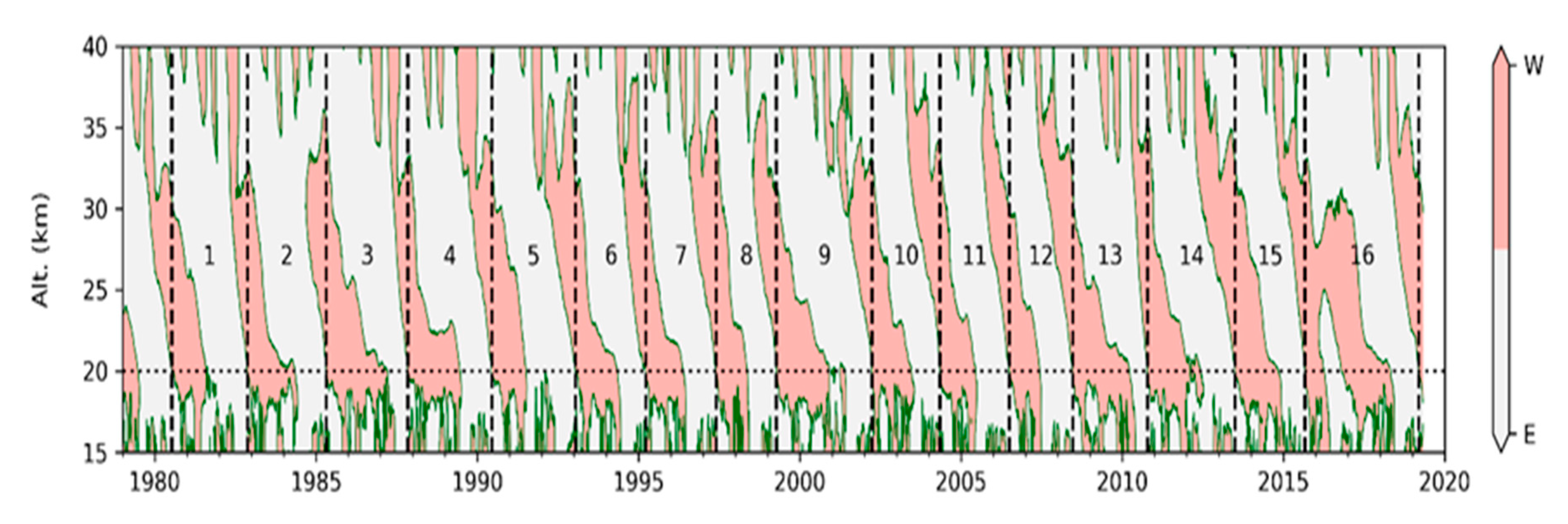
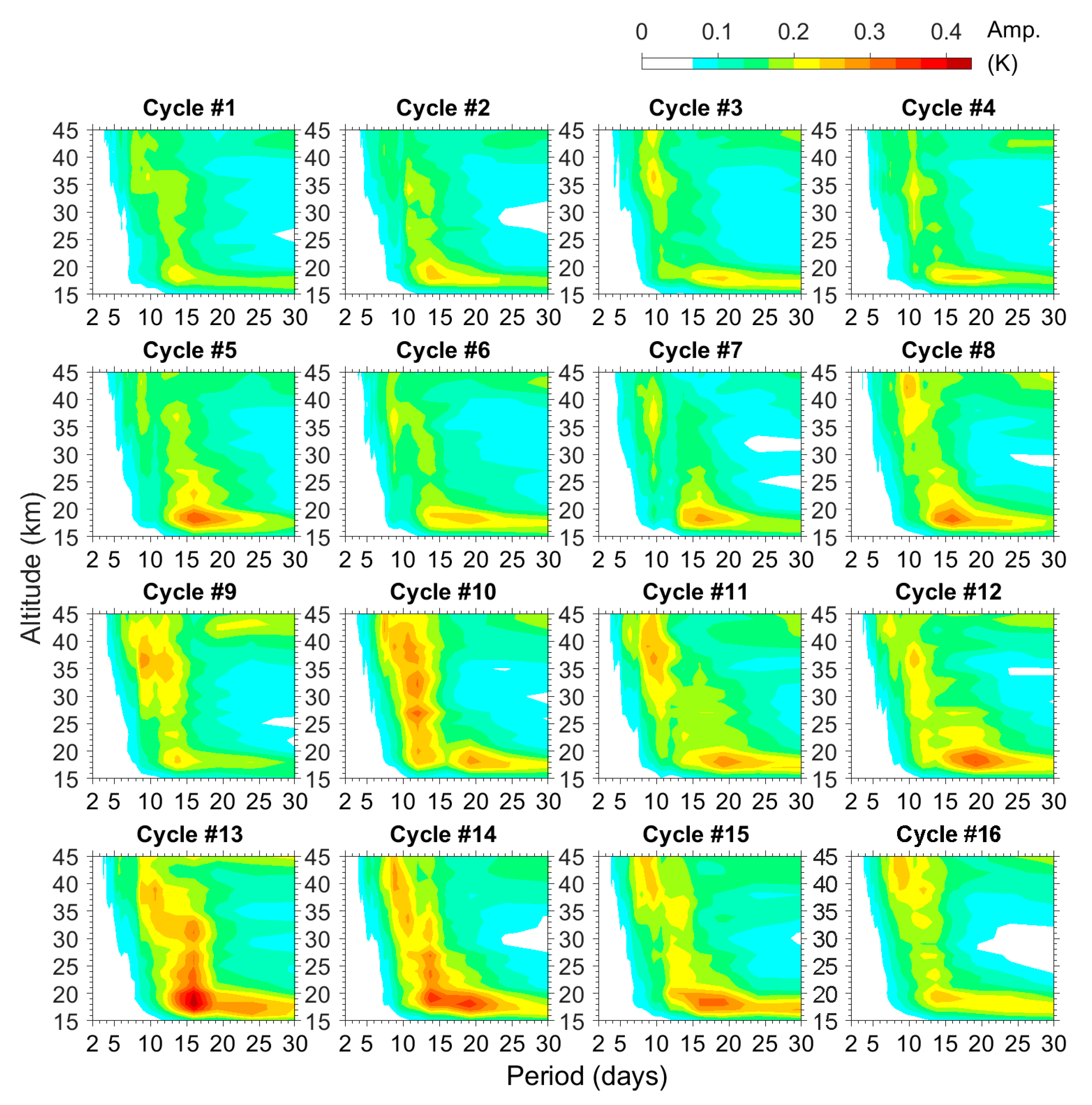
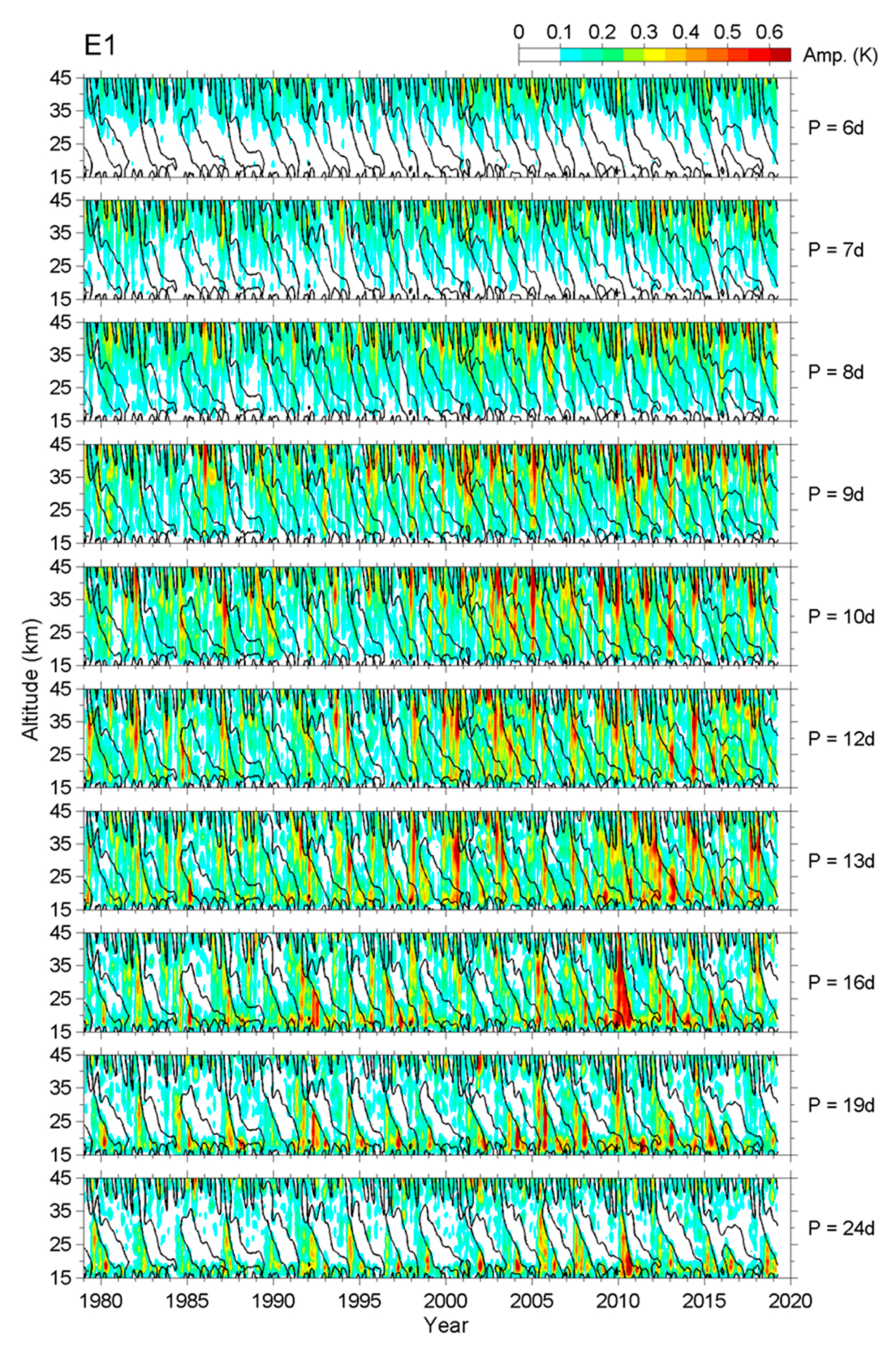
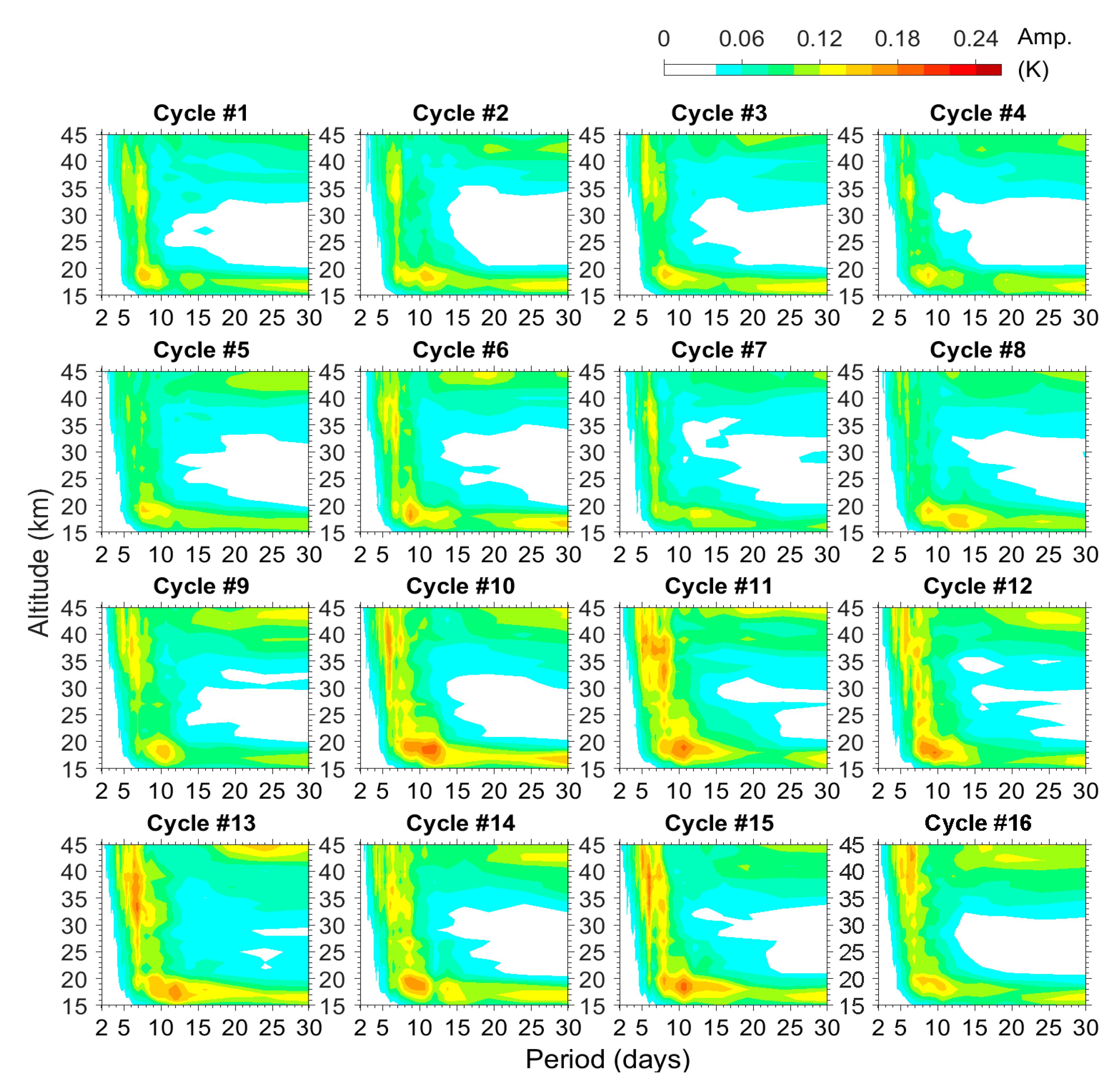
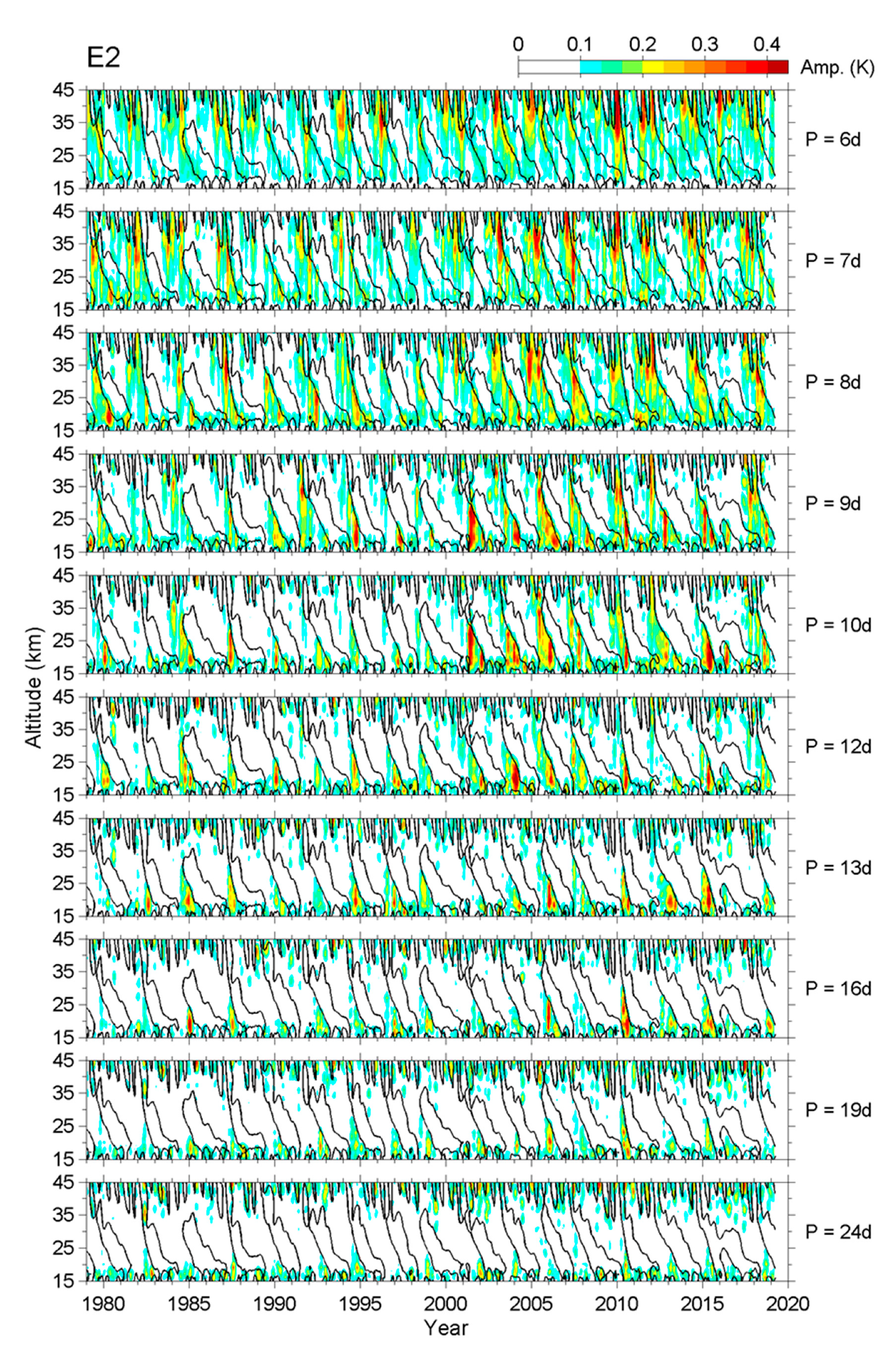
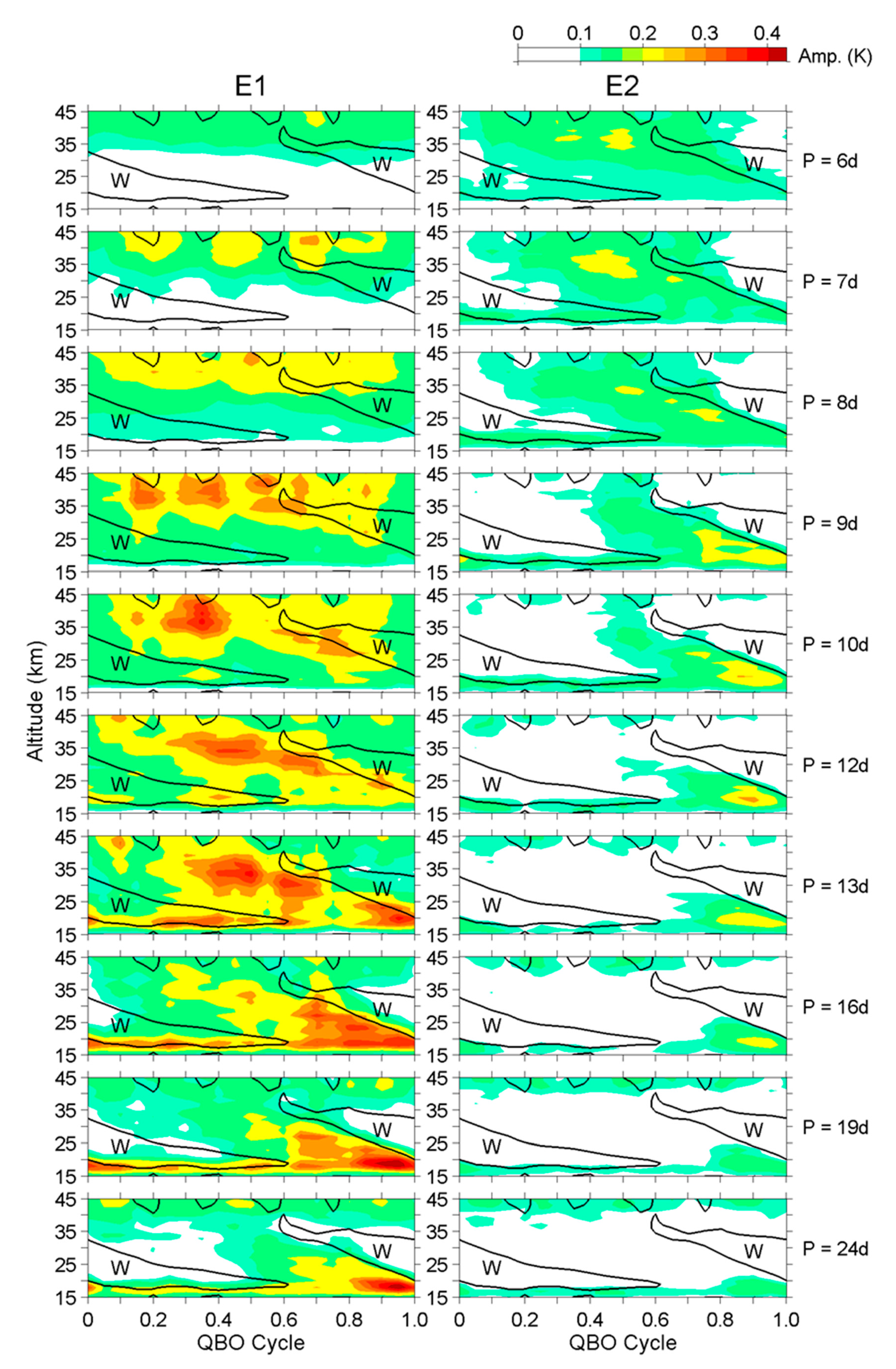
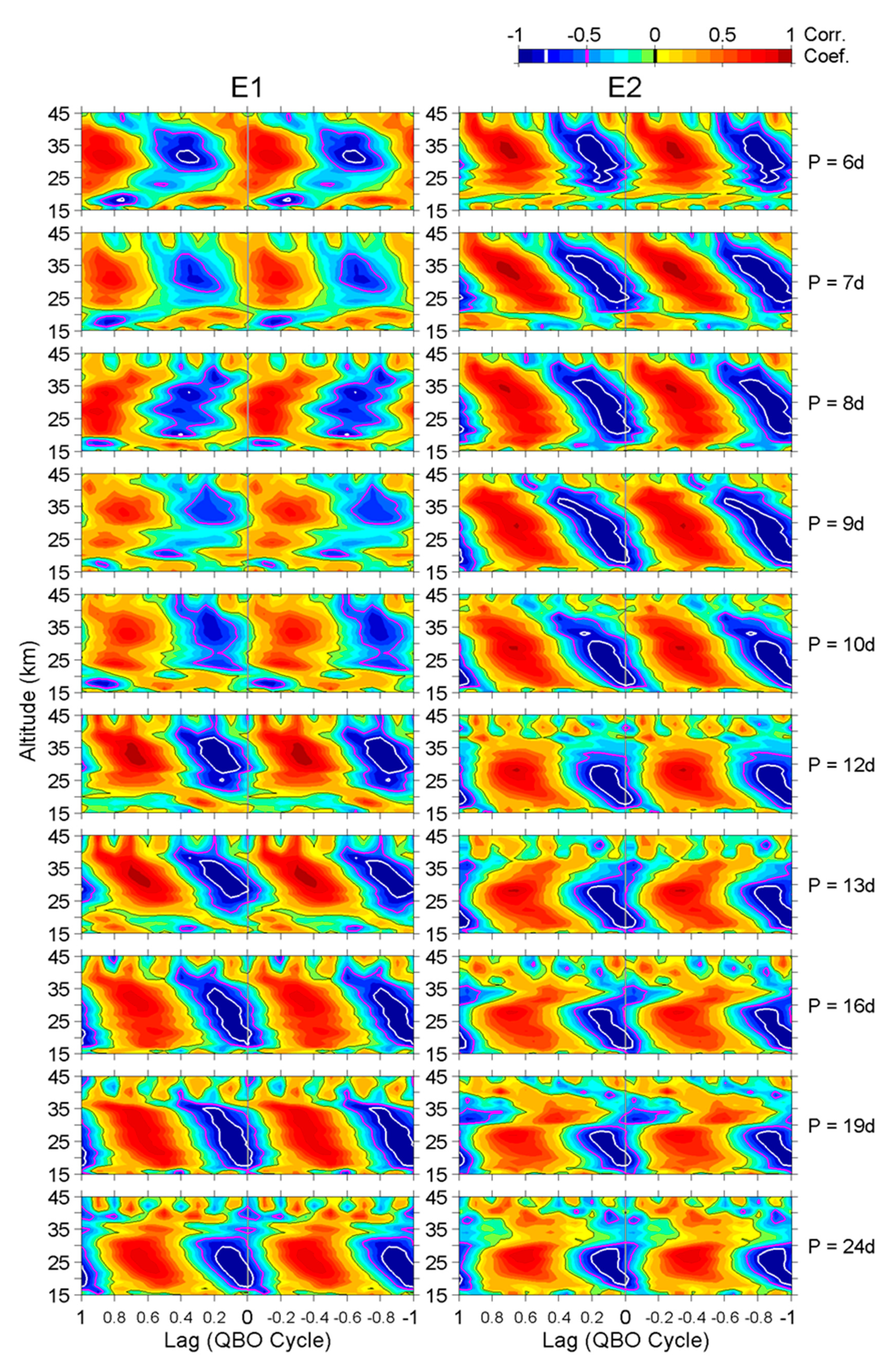
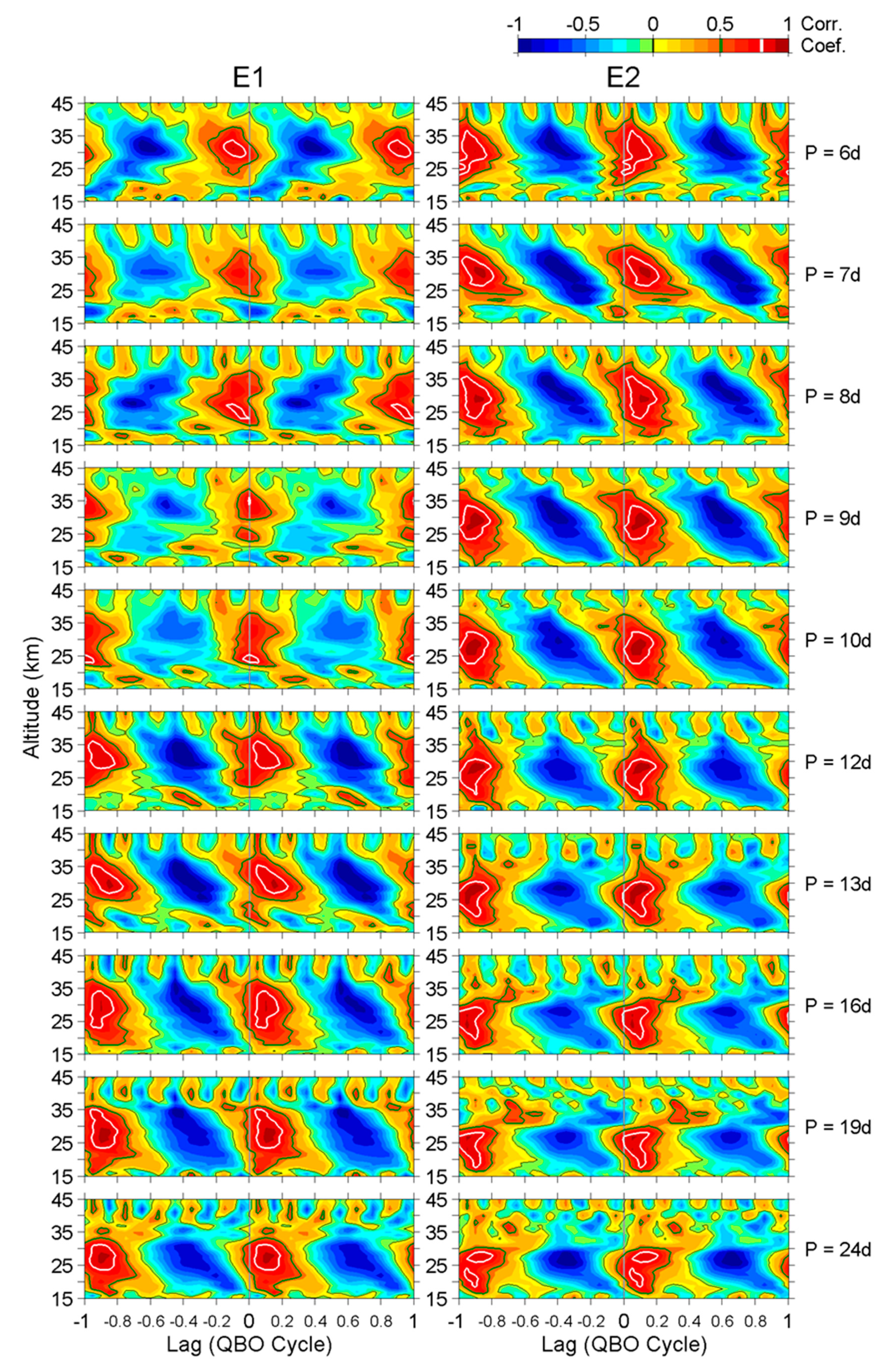
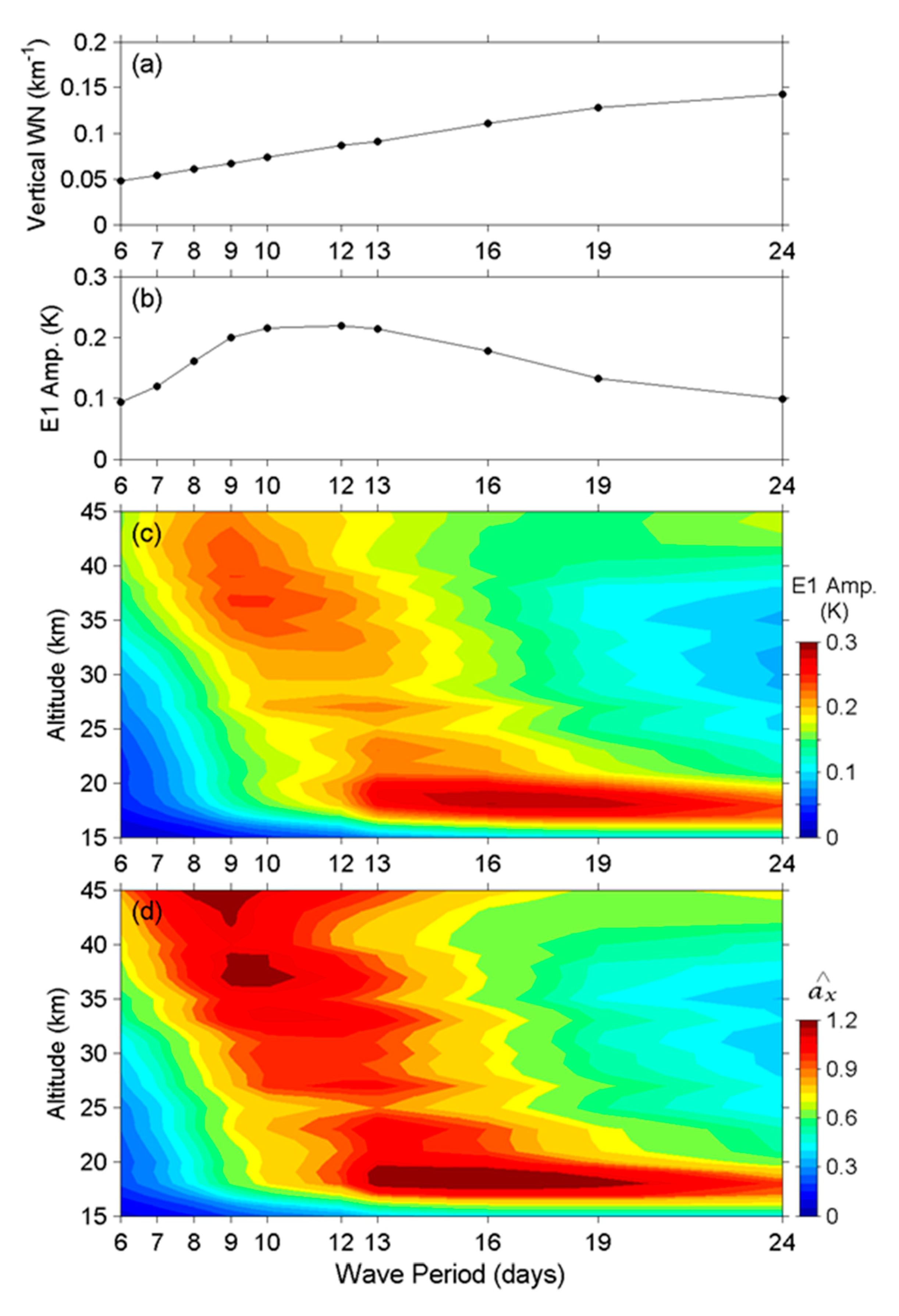
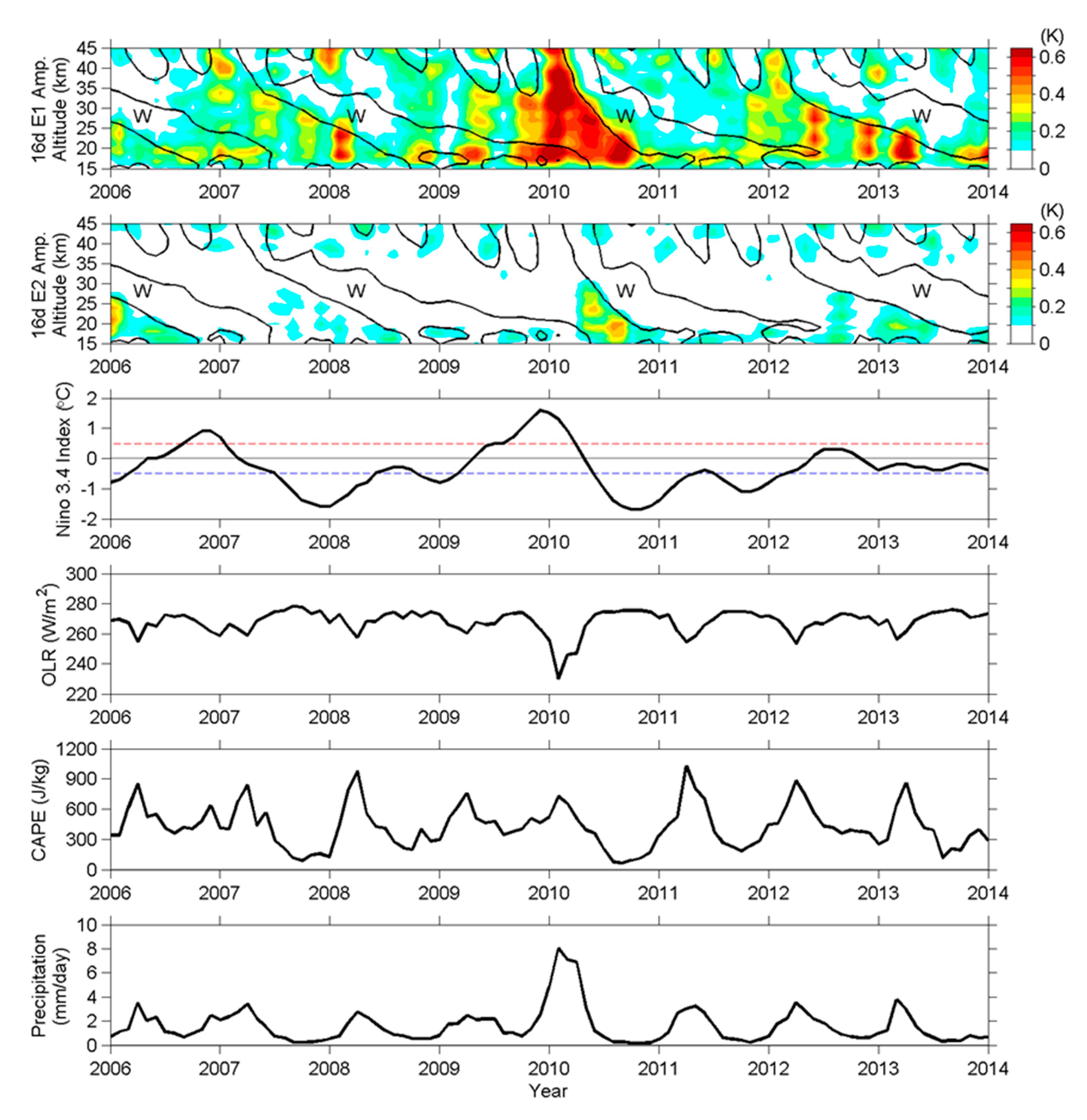

© 2020 by the authors. Licensee MDPI, Basel, Switzerland. This article is an open access article distributed under the terms and conditions of the Creative Commons Attribution (CC BY) license (http://creativecommons.org/licenses/by/4.0/).
Share and Cite
Pan, C.-J.; Yang, S.-S.; Das, U.; Chen, W.-S. Morphology of the Wavenumber 1 and Wavenumber 2 Stratospheric Kelvin Waves Using the Long-Term Era-Interim Reanalysis Dataset. Atmosphere 2020, 11, 421. https://doi.org/10.3390/atmos11040421
Pan C-J, Yang S-S, Das U, Chen W-S. Morphology of the Wavenumber 1 and Wavenumber 2 Stratospheric Kelvin Waves Using the Long-Term Era-Interim Reanalysis Dataset. Atmosphere. 2020; 11(4):421. https://doi.org/10.3390/atmos11040421
Chicago/Turabian StylePan, Chen-Jeih, Shih-Sian Yang, Uma Das, and Wei-Sheng Chen. 2020. "Morphology of the Wavenumber 1 and Wavenumber 2 Stratospheric Kelvin Waves Using the Long-Term Era-Interim Reanalysis Dataset" Atmosphere 11, no. 4: 421. https://doi.org/10.3390/atmos11040421
APA StylePan, C.-J., Yang, S.-S., Das, U., & Chen, W.-S. (2020). Morphology of the Wavenumber 1 and Wavenumber 2 Stratospheric Kelvin Waves Using the Long-Term Era-Interim Reanalysis Dataset. Atmosphere, 11(4), 421. https://doi.org/10.3390/atmos11040421




